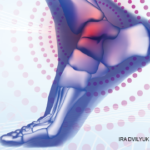There was hope for both Margaret and Cindy. To paraphrase William Shakespeare, what’s done can be undone—especially in the hands of a skilled spine surgeon.
The neck is not the only critical locomotor intersection between neurology and rheumatology. For example, in patients with stiff-person syndrome, autoantibodies circulating in the brain target the enzyme glutamic acid decarboxylase, rendering ineffective most of the inhibitory motor pathways that regulate muscle contraction. The resulting Frankenstein gait is a memorable term that aptly describes the ensuing stiff, awkward walking style. Once you have seen it, you will never forget it. Similarly, when examining patients with vasculitic neuropathy, you hope not to hear the slapping sound of a denervated foot striking a hardwood floor. This is a sickening noise, heralding the major therapeutic and rehabilitation challenges facing a patient with a foot drop.
Standing Straight
Walking is an integral activity in our lives. However, walking upright is a relatively recent development in the evolution of apes and human-like creatures, the hominids, having occurred just a few million years ago. With a paucity of supporting evidence, Charles Darwin speculated that humans evolved in Africa and were most closely related to the African great apes. He also reasoned that the origin of bipedal locomotion was a critical event, one that set humans on a separate evolutionary trajectory from their ape relatives.2
The continued stubborn resistance of osteoarthritis to most, if not all, therapeutic interventions assures the long-term viability of the orthopedic implant industry.
According to Daniel Lieberman, PhD, professor of biological sciences at Harvard University in Cambridge, Mass., Darwin believed that natural selection favored an ape that stood upright, freeing its hands to carry objects and to make tools. Although walking upright reduced energy costs and liberated the hands, it also constrained our ancestors to be slower creatures. Their competition, the other apes and chimpanzees, were knuckle-walkers, a faster but more energy-expending form of locomotion. The loss of speed when walking upright was compensated by the ability of hominids to become endurance walkers and runners. This development provided a great advantage for our ancestors who could now pursue their prey and outlast them in the chase. Their diets shifted from eating plants, shoots and berries to rich animal protein, laden with fat and marrow. The original Paleo diet! Having access to protein and fat may have enabled a very significant evolutionary breakthrough. It was only after this dietary change that the hominids’ brains began to enlarge. It seems that the previously low-calorie, low-cholesterol diet constrained the size of the brain, a costly organ to grow and to maintain. Hominids became better skilled at hunting, and their newly acquired social skills enabled them to collaborate with others to capture prey that previously was too powerful or too fast to kill. Larger brains offered more advanced linguistic and cognitive abilities. In short, Darwin’s speculation was that without bipedalism, humans might never have evolved.3
